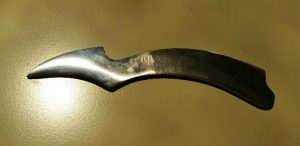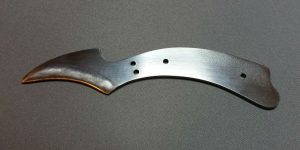The Scale of Injustice
August 21st, 2016I Saved Two Bucks
My sixth sense tells me people are dying to know how my knife-making efforts are going. Fear not. Relief is at hand.
Here’s a photo of the knife I”m making. Again, as if you hadn’t memorized every detail, this is a birds beak paring knife, but it’s actually a poultry-boning knife. I like birds beak knives for boning poultry.
The steel is 440C, which is a very nice grade of stainless. It’s a lot better than the crap many manufacturers are putting in their knives these days.
Let’s see. Where to start.
Scale.
Scale is oxidized metal. If metal is processed at high temperatures, scale forms on it. If the scale is on the metal when it comes from the steel mill, it’s called “mill scale.” It’s harder than metal, so removing it is a real pain. It can dull cutting bits, and it’s hard on abrasives. You can buy metal with the scale removed, but I saw that this was a silly waste of money, so I saved two dollars and got the scaly stuff, and I’m spending the last two weeks of August removing the crud. I am a smart shopper. Clearly.
I have people trying to tell me stainless steel doesn’t have scale. Yeah, okay. Everyone in the steel business disagrees with you, and I have scaly steel right here in my house, but…okay.
I shaped my knife, and then I used abrasives to get most of the scale off, but the last bits are the hardest to remove. On top of that, the steel bar I bought is wavy, so you have to sand the high spots off before the scale in the low spots starts to move. I would guess that the dips in the metal are only a thousandth or two deep, but that’s a lot when you’re removing metal from relatively hard steel using a sharpening stone and elbow grease.
I can tell the steel is wavy because wherever there is scale on one side of the blade, indicating a low spot, there is bare metal on the other side, indicating a high spot. Think about it, and you will understand.
I figured I was too smart to let this problem slow me down. I Googled for answers. I read that vinegar takes scale off. Maybe that’s true for carbon steel. I don’t know. It did virtually nothing for 440C.
The next step: electrolysis. I put baking soda in a container of water, and I connected a steel anode and the blade to a battery charger. After several hours, I had a layer of green stuff in the water, plus some rust, but I hadn’t made much progress.
It occurred to me that the green stuff might be a chromium compound. Chromium is found in green pigments. I figured that meant something was happening, but it wasn’t getting the job done.
I wondered why other people weren’t using electrolysis, and then it occurred to me that I might be making something poisonous. I looked chromium up and learned that there is a horrible poison called hexavalent chromium. Apparently you can get cancer just from reading about it (sorry). I hope I didn’t make that.
It didn’t taste too bad.
I considered supergluing the steel to something so I could mount it on the lathe chuck. That would allow me to face the crap off. Then I pictured the blade coming loose at 500 RPM’s. I considered trying the same strategy in the mill.
In the end, I went back to the drill press and sanding drum, along with the diamond sharpening stone. Tedious, but guaranteed to work.
You can remove scale with a belt grinder, but a belt grinder will shape the blade as it grinds. At the very least, it will round it at the edges. I plan to glue micarta scales to this thing. If the steel’s edges are rounded, there will be gaps between the micarta and the steel. It looks like you have to descale the knife before establishing the final contour. Then you can shape it to fit the handle scales. I did not do this.
It occurred to me that reducing the area of the steel touching the abrasive would shorten the descaling time, so I fired up the belt grinder–with trepidation–and started shaping the concave edge I foolishly designed into the knife. A concave edge is harder to grind than a convex or straight edge. I realized that after I was committed to the job.
Grinding went really, really badly. At first. I had no idea what I was doing. I hacked and gouged the steel. I started to think I was ruining it. After a while, though, bits of skill began to materialize somewhere inside me. By the time I was done, I had something that looked very good. I moved to a finer belt, and then I buffed parts of the blade with my 25,000-RPM dental lathe.
It’s not done yet, but I have less metal to finish now. Once every last corrosion pit is gone, I’m going to buff everything that will stick out past the handles, drill the knife for rods to hold the bolsters, drill it for fasteners to hold the scales on, and ship it off to be heat-treated. Sweet.
I can do this. If my first knife looks this good, the knives I’ll make two months from now will be nearly perfect.
I keep learning things. Today I learned that polished knives rust less than shiny ones. The scratches provide more surface area and more places where rust can take hold. That’s not an issue with 440C, but it’s good to know for future knives.
I also learned that 154CM is just as good as 440C, so if I can’t find 440C, I can order 154CM. It’s not exactly the same, but the pluses and minuses balance out to where I would be just as happy with it.
Another bonus: you can make knife-making pay for itself. Most hobbies don’t work that way. It’s very hard to make a living selling handmade knives, but it’s not hard at all to pay for your tools and materials, plus, possibly, beer. Nice.
The disappointing thing is that you can’t make real money at this. The well-known makers who attract drooling mobs of toadies at knife shows are generally either retired or dependent on their wives. That sucks some of the macho out of the business.
“This is my 14-inch cryo-treated 1,000,000-layer Damascus ‘Fang o’ Death II.’ I wanted to make it 18 inches, but Martha wouldn’t give me an advance on my allowance.”
Before I got started on this, I felt bad about having a small 1×42 grinder. It’s pretty slow for shaping things. But now I realize it’s a fantastic knife-making tool, because it can get into places better than a 2×72. If you have both sizes, you’re cooking with gas.
I still have enough scaly steel to make a second knife. I guess I’ll come up with something.
News will be posted here as it occurs.
More
Here’s the latest. The metal is cleaned up about as well as I intend to get it, and I’ve drilled holes for bolster pins and Corby bolts. As you surely know, Corby bolts are fasteners that hold handle scales on.
It’s about time to mail this thing off for hardening.


August 21st, 2016 at 5:15 PM
Bonus points for the pun in the title.
August 21st, 2016 at 7:19 PM
I try to keep it lively.
August 22nd, 2016 at 8:29 AM
Can you make one in tactical?
August 22nd, 2016 at 10:14 AM
Where would I get tactical turkeys?